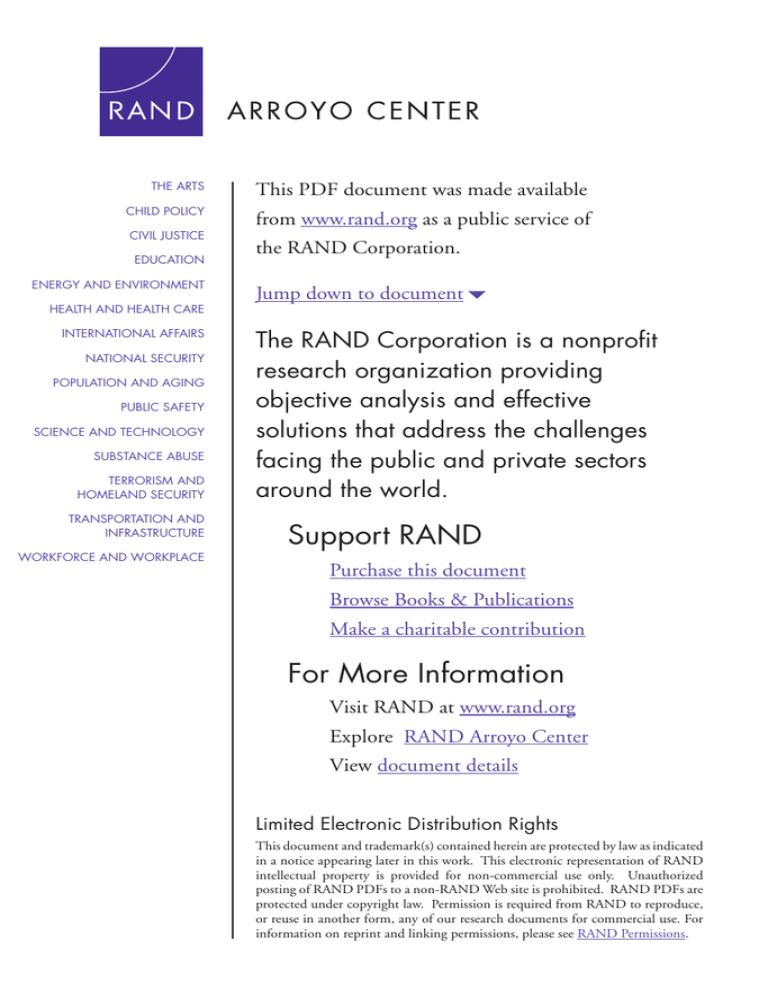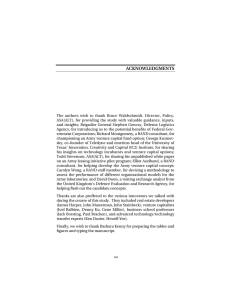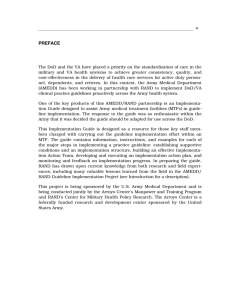
THE ARTS
This PDF document was made available
CHILD POLICY
from www.rand.org as a public service of
CIVIL JUSTICE
EDUCATION
ENERGY AND ENVIRONMENT
HEALTH AND HEALTH CARE
INTERNATIONAL AFFAIRS
NATIONAL SECURITY
POPULATION AND AGING
PUBLIC SAFETY
SCIENCE AND TECHNOLOGY
SUBSTANCE ABUSE
TERRORISM AND
HOMELAND SECURITY
TRANSPORTATION AND
INFRASTRUCTURE
WORKFORCE AND WORKPLACE
the RAND Corporation.
Jump down to document6
The RAND Corporation is a nonprofit
research organization providing
objective analysis and effective
solutions that address the challenges
facing the public and private sectors
around the world.
Support RAND
Purchase this document
Browse Books & Publications
Make a charitable contribution
For More Information
Visit RAND at www.rand.org
Explore RAND Arroyo Center
View document details
Limited Electronic Distribution Rights
This document and trademark(s) contained herein are protected by law as indicated
in a notice appearing later in this work. This electronic representation of RAND
intellectual property is provided for non-commercial use only. Unauthorized
posting of RAND PDFs to a non-RAND Web site is prohibited. RAND PDFs are
protected under copyright law. Permission is required from RAND to reproduce,
or reuse in another form, any of our research documents for commercial use. For
information on reprint and linking permissions, please see RAND Permissions.
This product is part of the RAND Corporation monograph series.
RAND monographs present major research findings that address the
challenges facing the public and private sectors. All RAND monographs undergo rigorous peer review to ensure high standards for
research quality and objectivity.
A Capabilities-Based
Strategy for Army
Security Cooperation
Jennifer D. P. Moroney, Adam Grissom, Jefferson P. Marquis
Prepared for the United States Army
Approved for public release; distribution unlimited
AR R OYO CENTE R
The research described in this report was sponsored by the United States
Army under Contract No. DASW01-01-C-0003.
Library of Congress Cataloging-in-Publication Data
Moroney, Jennifer D. P., 1973–
A capabilities-based strategy for Army security cooperation / Jennifer D.P.
Moroney, Adam Grissom, Jefferson P. Marquis.
p. cm.
Includes bibliographical references.
ISBN 978-0-8330-4199-9 (pbk. : alk. paper)
1. Combined operations (Military science) 2. United States. Army. 3. Military
planning—United States—Methodology. 4. Multinational armed forces—
Organization. 5. Military assistance, American. 6. United States—Military
relations—Foreign countries. 7. Military art and science—International cooperation.
I. Grissom, Adam. II. Marquis, Jefferson P. III. Title.
U260.M67 2007
355.4'6—dc22
2007030770
The RAND Corporation is a nonprofit research organization providing
objective analysis and effective solutions that address the challenges
facing the public and private sectors around the world. R AND’s
publications do not necessarily reflect the opinions of its research clients
and sponsors.
R® is a registered trademark.
Cover photo by Michael A. Osur.
© Copyright 2007 RAND Corporation
All rights reserved. No part of this book may be reproduced in any
form by any electronic or mechanical means (including photocopying,
recording, or information storage and retrieval) without permission in
writing from RAND.
Published 2007 by the RAND Corporation
1776 Main Street, P.O. Box 2138, Santa Monica, CA 90407-2138
1200 South Hayes Street, Arlington, VA 22202-5050
4570 Fifth Avenue, Suite 600, Pittsburgh, PA 15213-2665
RAND URL: http://www.rand.org/
To order RAND documents or to obtain additional information, contact
Distribution Services: Telephone: (310) 451-7002;
Fax: (310) 451-6915; Email: order@rand.org
Summary
This study outlines a planning framework for cultivating multinational
force compatibility (MFC) with armies that are not traditional allies.
Such coalition partners are increasingly important to the Army in the
post-9/11 security environment. Multilateral military operations are
often now conducted by “coalitions of the willing” rather than by alliances, and many of these ad hoc coalitions include key contingents
that have no history of sustained peacetime cooperation with the U.S.
Army. The Army has only very limited resources available to enhance
compatibility with non-allied partner armies, especially compared to
the resources devoted to compatibility with traditional allies such as
the United Kingdom. The challenge of enhancing compatibility and
building partnership capacity with non-core partner armies therefore
requires an innovative approach to planning.
Niche Capabilities: A New Approach to MFC Planning for
Army Security Cooperation
This study outlines an approach to MFC planning that focuses Army
resources on potential coalition partners that possess, or with assistance
could possess, niche capabilities that would augment U.S. Army capabilities in useful ways. The approach, which we term the Niche Capability Planning Framework, features a four-phase planning cycle. The
first phase focuses on characterizing and prioritizing candidate niche
capabilities to meet potential Army capability shortfalls. With global
responsibilities and limited resources, the Army is obliged to accept
xiii
xiv
A Capabilities-Based Strategy for Army Security Cooperation
risk in its investments in future capabilities. This risk is manifested in
decisions to eschew investment in capabilities that the Army desires
but cannot afford and, also, in decisions to acquire limited quantities
of some capabilities with the risk that there may not be enough of these
capabilities under certain circumstances.1 Some of these potential gaps
and shortfalls are likely to be more important than others, due to the
nature of the capability and the context in which it may be used. Some
may also be easier than others to develop in partner armies. Capabilities in which the Army has decided not to invest, but which are nevertheless potentially important to the Army’s effectiveness in a future
contingency and cost-effective to develop in non-core partner armies,
would be ideal niche capabilities. The first phase of the Niche Capability Planning Framework focuses on identifying such niche shortfalls
or gaps.
The second phase of the Niche Capability Planning Framework
focuses on assessing potential partner armies to identify those suited to
becoming niche contributors. In seeking potential non-core partners
from among the nearly 190 armies worldwide, Army planners must
gauge the political acceptability, willingness to cooperate, and existing capabilities of each. Armies that are eager to work with the United
States will make better niche partners than those that are ambivalent.
Armies that are in good standing with the U.S. government, from the
perspective of the broader bilateral political relationship, will make
better niche partners than those with which the U.S. government maintains a contentious relationship. Armies that already possess a desirable
niche capability, or the means to support a capability cultivated with
U.S. assistance, will be better niche partners than those that do not.
Phase two of the Niche Capability Planning Framework is devoted to
analyzing these issues.
The third phase of the Niche Capability Planning Framework
focuses on the development of an integrated program of military-to-
1
The recent cancellations of the Comanche scout helicopter and the Crusader artillery
system are examples of the first type of decision. The Army’s traditional reluctance to support a large active component Civil Affairs structure is an example of the second type of
decision.
Summary
xv
military contacts, security assistance, and other security cooperation
activities designed to cultivate capabilities in selected partner armies.
Ideally, this process will leverage Army security cooperation resources
with the Department of Defense (DoD) and Interagency security cooperation resources to accomplish the Army’s objectives at the least cost
to the service and the nation.
The fourth and final phase of the Niche Capability Planning
Framework is the execution of the phased program, coupled with continuing assessment and the development of appropriate measures of
effectiveness. This will allow the Army Staff to ensure that its plans are
being implemented and that lessons are learned and incorporated into
the plan over time. We envision the Niche Capability Planning Framework as a cycle that will be repeated periodically by Army planners.
Recommendations
We recommend that the Army incorporate a strategy for working with
non-core partner armies into the Army Security Cooperation Strategy
(ASCS). We further recommend that Army planners adopt a deliberate
planning framework for designing and implementing a niche capabilities strategy. This framework should, at a minimum, incorporate analyses of projected Army capability gaps, key partner characteristics, and
the resources required to match capabilities with partners in practice.
This report outlines such an approach in the form of the Niche Capability Planning Framework.




